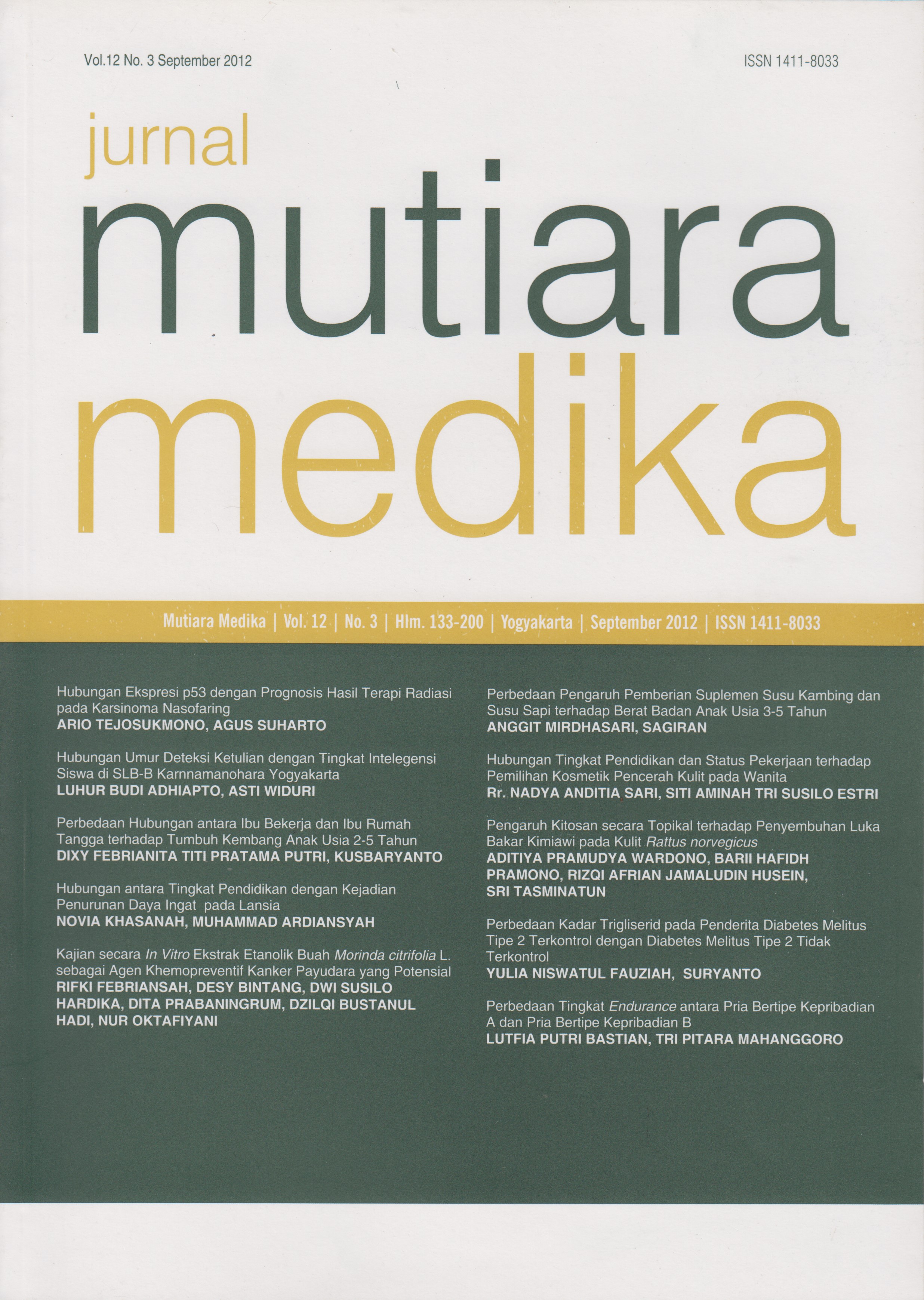Hubungan antara Tingkat Pendidikan dengan Kejadian Penurunan Daya Ingat pada Lansia
DOI:
https://doi.org/10.18196/mmjkk.v12i3.1035Keywords:
demensia, lansia, tingkat pendidikan, dementia, elderly, education levelAbstract
Prevalensi terjadinya demensia pada lansia di Indonesia semakin meningkat. Demensia dapat terjadi karena berbagai faktor. Tingkat pendidikan merupakan salah satu faktor yang memiliki hubungan dengan kejadian demensia pada lansia. Penelitian ini bertujuan untuk mengetahui hubungan tingkat pendidikan dengan kejadian demensia pada lansia. Penelitian ini dilaksanakan di Panti Sosial Tresna Wredha Yogyakarta unit Abiyoso dan Budiluhur. Jenis penelitian ini adalah analitik observasional dengan pendekatan studi cross sectional. Sampel yang diambil dengan menggunakan teknik purposive sampling berjumlah 32 orang lansia usia 70-80 tahun, dengan kriteria inklusi dan eksklusi tertentu, dengan menggunakan data dari kuesioner, serta instrument MMSE (Mini Mental State Examination) untuk mengetahui derajat demensia pada respoden tersebut. Data yang diperoleh dianalisis dengan menggunakan uji korelasi Spearman dan hasil perhitungan didapatkan hasil korelasi negatif kuat (r=-0,686), dengan nilai p 0,01 (p<0,05), maka ada hubungan yang signifikan. Penelitian ini menunjukkan terdapat hubungan antara tingkat pendidikan dengan kejadian demensia pada lansia.
The prevalence of dementia in Indonesia is increasing. Dementia is caused by many factors. Level of education is one of the dementia related factors in elderly. The aim of the research is to identify the correlation between level of education and dementia in elderly. The location of research at Panti Sosial Tresna Wredha Abiyoso and Budiluhur unit. This research is analytic observational which is using cross sectional study. Sampel is taken with purposive technique sampling, 32 elderly 70 – 80 years old, with inclution and exclution criteria. This research is using data from questioner, and also MMSE (Mini Mental State Examination) to asses their dementia degree. The data analysed with Spearman correlation. The result of correlation is r=-0,686, and p value = 0,01 which is p value < 0,05, it means that the correlation is significant. Based on the result obove show there is significant correlation between level of education with dementia.
References
Kaplan, H.I., Sadock, B.J. & Grebb, J.A. Sinopsis Psikiatri; Ilmu Pengetahuan Perilaku Psikiatri Klinis Edisi Ketujuh Jilid 2. Jakarta: Binarupa Aksara. 1997. (Buku asli diterbitkan 2006).
Sondakh, N. Mengenal Penyakit Demensia (2): Mudah Lupa, Harus Diwaspada. Diakses pada tanggal 8 April 2009. 2008. Diakses dari http:/ /klinikneurologi.com/?p=3.
Sudoyo W.A, Setiyohadi, B., Alwi, I., K. Marcellus S., Setiati, S. Buku Ajar Ilmu Penyakit Dalam. jilid III. edisi IV. Jakarta: Pusat Penerbitan, Departemen Ilmu Penyakit Dalam Fakultas Kedokteran Universitas Indonesia. 2006 . Hal. 1874-1875.
Ngandu T, Von Strauss E, Helkala El, Winblad B, Nissinen A, Tuomilehto J, et al. Education and Dementia: what Lies Behind the Association? Neurology. 2007; 69(14): 1442-1450.
Hasbullah. Dasar-dasar Ilmu Pendidikan. Jakarta: PT. Raja Grafindo Persada. 2005.
Japardi, I. Penyebab Penyakit Alzheimer. Fakultas Kedokteran Bagian Bedah Universitas Sumatera Utara, (Ethical Digest: Alzaimer, 153 edisi 45, November 2007). 2007. Diakses pada tanggal 12 April 2009.
Salmon DP, Riekkinen PJ, Katzman R, Zhang MY, Jin H, Yu E. Cross-Cultural Studies of Dementia: A Comparoson of Mini Mental State Examination Performance in Finland and China. Arch Neurol. 1989; 46 (7): 769-72.
Lumbantobing, D.M. Kecerdasan Pada Usia Lanjut dan Demensia. Jakarta: Balai Penerbit FK UI. 1995.
Francisco, C., Montserrat, C., Agustín,M.M., and Bahi, T. Education and Dementia: A MetaAnalytic Study. Neuroepidemiology. 2006. 26 (4): 226-232.
Schmand. B., Jonker, C., Hooijer, C., Lindeboom, J. Subjective memory complaints may announce dementia. Neurology. 1996; 46 (1): 121-125.
Downloads
Published
Issue
Section
License
Copyright
Authors retain copyright and grant Mutiara Medika: Jurnal Kedokteran dan Kesehatan (MMJKK) the right of first publication with the work simultaneously licensed under an Attribution 4.0 International (CC BY 4.0) that allows others to remix, adapt and build upon the work with an acknowledgment of the work's authorship and of the initial publication in Mutiara Medika: Jurnal Kedokteran dan Kesehatan (MMJKK).
Authors are permitted to copy and redistribute the journal's published version of the work (e.g., post it to an institutional repository or publish it in a book), with an acknowledgment of its initial publication in Mutiara Medika: Jurnal Kedokteran dan Kesehatan (MMJKK).
License
Articles published in the Mutiara Medika: Jurnal Kedokteran dan Kesehatan (MMJKK) are licensed under an Attribution 4.0 International (CC BY 4.0) license. You are free to:
- Share — copy and redistribute the material in any medium or format.
- Adapt — remix, transform, and build upon the material for any purpose, even commercially.
This license is acceptable for Free Cultural Works. The licensor cannot revoke these freedoms as long as you follow the license terms. Under the following terms:
Attribution — You must give appropriate credit, provide a link to the license, and indicate if changes were made. You may do so in any reasonable manner, but not in any way that suggests the licensor endorses you or your use.
- No additional restrictions — You may not apply legal terms or technological measures that legally restrict others from doing anything the license permits.






